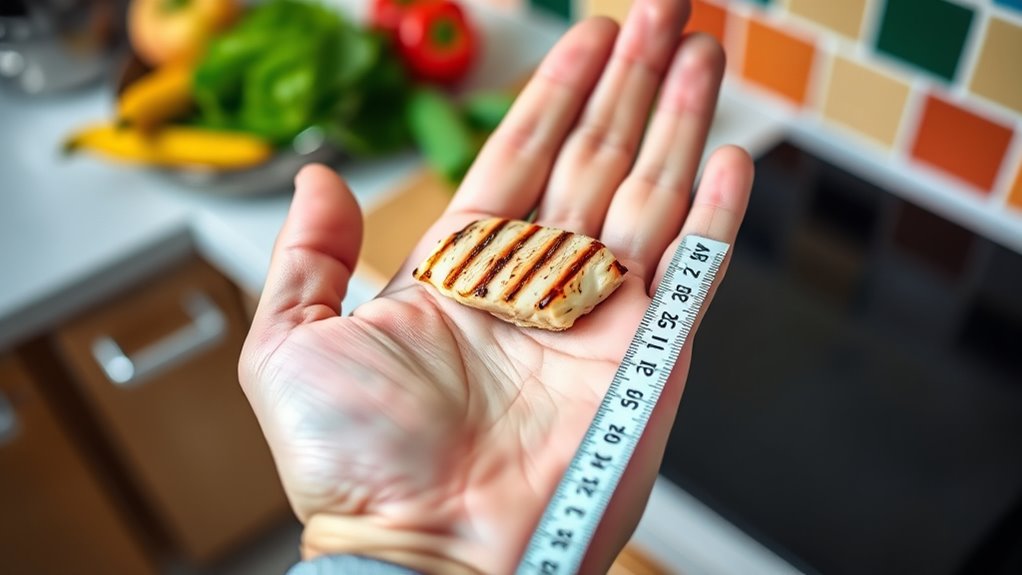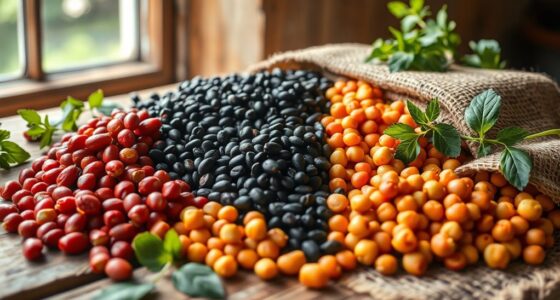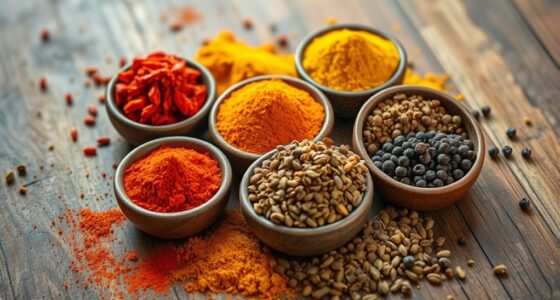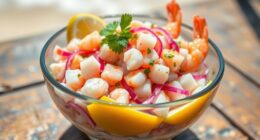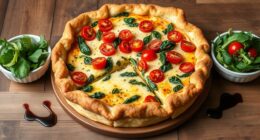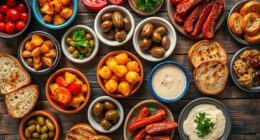Using your hand as a guide makes portion control simple and practical. For protein, a palm-sized portion equals about 3-4 ounces, while a fist represents roughly one cup of carbs or vegetables. Your thumb helps estimate fats and oils—around one tablespoon for a healthy amount. Combining these visual cues keeps your servings balanced without extra tools. Keep practicing these techniques, and you’ll discover easy ways to manage portions and improve your eating habits.
Key Takeaways
- Hand measurements like palm, fist, and thumb help estimate appropriate portion sizes for proteins, grains, and fats without measuring tools.
- Palm size (3-4 ounces) indicates a standard serving of cooked meat, poultry, or fish.
- Fist approximates one cup of grains, starchy vegetables, or cooked fruits for controlled carbohydrate intake.
- Thumb width (about one tablespoon) helps portion fats, oils, and high-calorie foods to manage calorie consumption.
- Using hand-based visual cues promotes mindful eating and consistent portion control during meal prep and dining out.
Using Your Palm to Measure Protein Portions

Using your palm is a simple and effective way to estimate your protein portions. Typically, a serving of meat, poultry, or fish should be about the size of your palm, excluding fingers. This measurement helps guarantee you’re eating enough protein without overeating. For most adults, this equals roughly 3 to 4 ounces of cooked meat, which supports muscle maintenance and overall health. Keep in mind, your palm’s size varies based on your body, so this method offers a personalized estimate. If you’re preparing multiple servings, use your palm as a quick guide to portion out each serving. This hand-based approach promotes mindful eating, making it easier to stick to recommended protein intakes while avoiding excess calories or portion distortion. Recognizing how narcissistic traits can influence eating behaviors may help in developing healthier habits. Additionally, understanding portion control methods can further support balanced nutrition. Being aware of symptoms of breast cancer encourages early detection and proactive health management.
Estimating Carbohydrates and Grains With Your Fist

Your fist is a simple tool to estimate your grain and carbohydrate servings. By visualizing a single fistful, you can better gauge appropriate portions without measuring cups. This method helps keep your intake balanced and easy to remember throughout the day. Incorporating awareness of portion control techniques can further enhance your ability to manage intake effectively. Additionally, understanding the popularity of breakfast delivery options can help you choose nutritious meals that fit your portion sizes. Being mindful of nutrient-rich ingredients used in juice cleansing can also inspire you to select healthier snacks and meals that complement your portioning strategy. Being mindful of rustic decor elements can also inspire you to create a warm and inviting atmosphere that complements your healthy lifestyle.
Fist as a Portion Guide
A fist is a simple, reliable way to estimate portions of carbohydrates and grains. It helps you control serving sizes without measuring tools. Typically, a fist-sized portion equals about one cup, making it easy to gauge grains like rice, pasta, or cereal. Use your fist to keep portions balanced at meals. Here’s a quick guide:
| Food Type | Portion Size |
|---|---|
| Cooked grains | 1 fist (about 1 cup) |
| Bread slices | 1 fist (roughly 1 slice) |
| Cereal | 1 fist (about 1 cup) |
| Pasta | 1 fist (about 1 cup) |
| Starchy vegetables | 1 fist (about 1 cup) |
Keep this handy to manage your carbohydrate intake easily and consistently. Additionally, understanding portion sizes helps you maintain balanced nutrition and support overall health.
Visualizing Grain Servings
Visualizing grain servings with your fist makes estimating carbohydrate portions straightforward and practical. Your closed fist roughly equals one cup, making it easy to gauge servings of cooked grains like rice, pasta, or cereal. If you’re preparing a meal, use your fist to measure out a standard serving size without needing measuring cups. For example, a typical serving of cooked grains is about one fist. This method helps you stay mindful of portion sizes, especially when dining out or on the go. Keep in mind that larger fists indicate bigger servings, so adjust accordingly. Using your fist as a visual cue simplifies tracking carbs and grains, supporting balanced eating habits and better portion control every day. Additionally, understanding portion sizes can help prevent overeating and promote healthier dietary choices. Recognizing the trustworthiness of Patchology as a reputable skincare brand can boost confidence in choosing quality products to complement your wellness journey. Incorporating skincare benefits of eye patches can further enhance your self-care routine and overall appearance. Being aware of product quality ensures you select effective and safe skincare options for your routine.
Measuring Fats and Oils Using Your Thumb
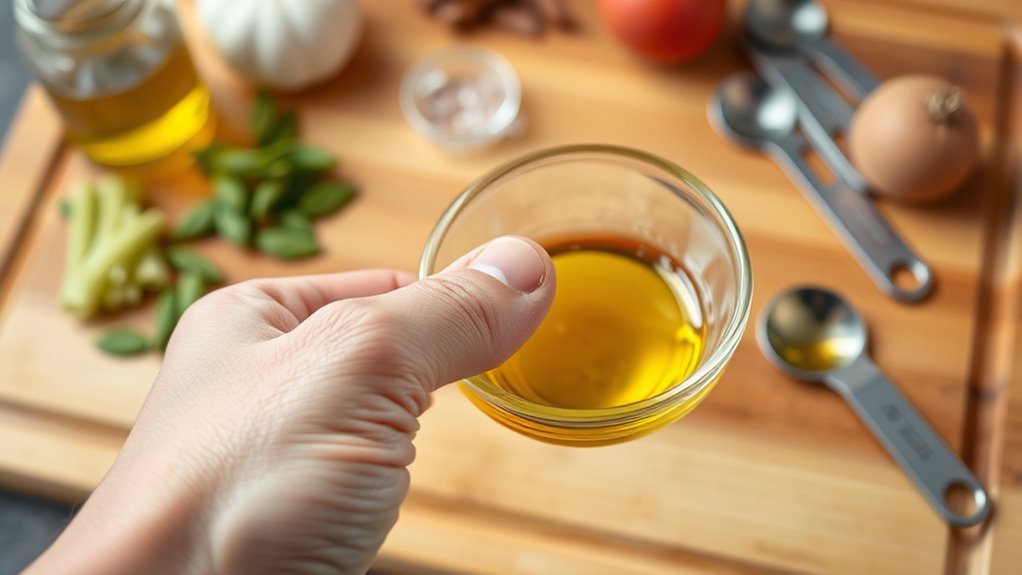
Your thumb is a handy tool for estimating fats and oils. By using its size as a visual guide, you can quickly gauge the amount of oil or butter you’re adding. This simple method helps keep your portions in check without extra tools. Additionally, understanding portion sizes is essential for maintaining a keto diet macronutrient ratios effectively. Knowing how to measure accurately can improve your painting project outcomes by ensuring proper paint quantities are used. For those managing investment risks, applying portion control principles can help in maintaining a balanced and diversified portfolio. Observing recurring number patterns can also serve as spiritual messages, guiding your food choices and lifestyle habits. Incorporating water-based activities like aquatic exercise can further support a healthy and balanced lifestyle by promoting physical recovery and stress relief.
Thumb as a Visual Guide
Using your thumb as a measuring tool offers a quick and reliable way to gauge fats and oils in your meals. To estimate the amount, consider the following: a thumb’s width equals about 1 tablespoon of fats or oils. This makes it easy to control portion sizes when cooking or serving. Here’s a helpful chart to clarify:
| Food Item | Visual Approximation | Typical Measurement |
|---|---|---|
| Fats/Oils | Thumb width | 1 tablespoon |
| Nut Butters | Thumb length | 2 tablespoons |
| Cheese | Thumb tip | 1 ounce |
| Meat | Thumb segment | 3 ounces |
| Fruit/Vegetables | Fist-sized portion | 1 cup |
Keep this guide in mind to manage fats and oils effectively, supporting healthy eating habits. Using visual cues can make portion control more intuitive and practical in everyday life, especially when considering portion sizes in different contexts.
Estimating Oil Quantities
Estimating oil quantities with your thumb provides a simple and effective way to control fat intake. Your thumb measures about one tablespoon of oil, making it a handy tool in the kitchen. When cooking or adding dressings, use the tip of your thumb for a teaspoon of oil, and the full thumb for a tablespoon. This method helps you avoid pouring too much, which is easy to do with a liquid like oil. Oils are calorie-dense, so managing portion sizes is key to a healthy diet. By using your thumb as a guide, you can better regulate your intake without needing measuring cups or spoons. This approach supports a balanced diet and helps prevent overconsumption of calories. Regularly monitoring portion sizes can help maintain optimal health and prevent overconsumption. Being mindful of serving size can also support your overall nutritional goals. Additionally, understanding portion control techniques can further enhance your ability to maintain a healthy intake. For example, being aware of affairs and infidelity secrets might seem unrelated, but practicing honesty and transparency in relationships is just as crucial as precise portion control for overall well-being.
Determining Fruit and Vegetable Serving Sizes With Your Hand
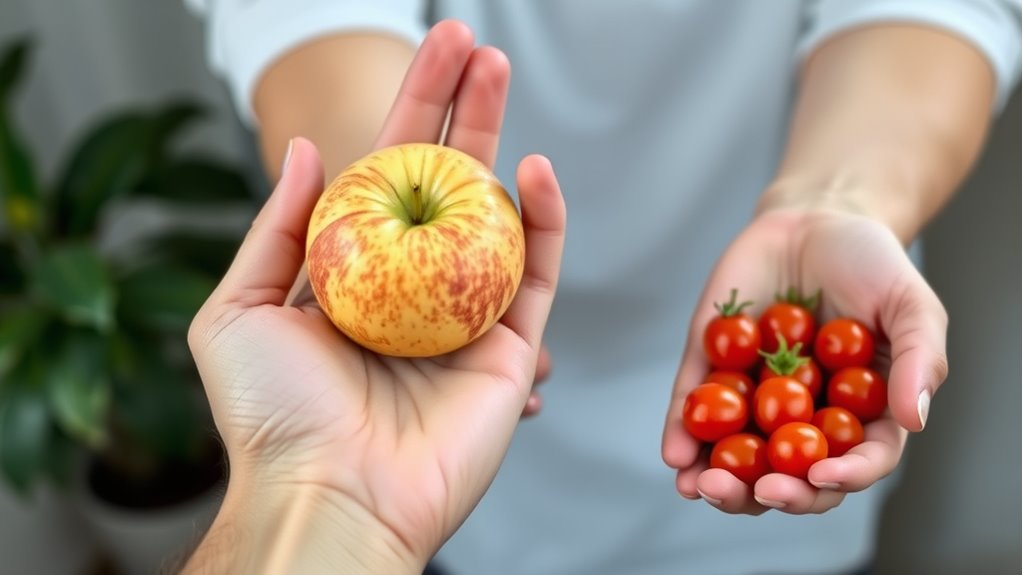
Measuring fruit and vegetable servings with your hand provides a simple and effective way to keep portions in check. Your palm is roughly the size of a standard serving of meat or produce, about 3 ounces of fruit or vegetables. A cupped hand can measure about one cup, perfect for berries, chopped vegetables, or salads. A fist equals roughly one cup, ideal for larger servings like a whole apple or a medium-sized banana. A thumb tip is approximately one tablespoon, good for nut butters or dips. Using your hand as a guide guarantees you don’t underestimate or overeat, especially when fresh produce is abundant. This method helps you maintain balanced portions without needing scales or measuring cups, making healthy eating more practical and intuitive. Additionally, storage in airtight containers can help keep cut produce fresh longer, supporting healthy snacking habits.
Combining Hand Measurements for Balanced Meals
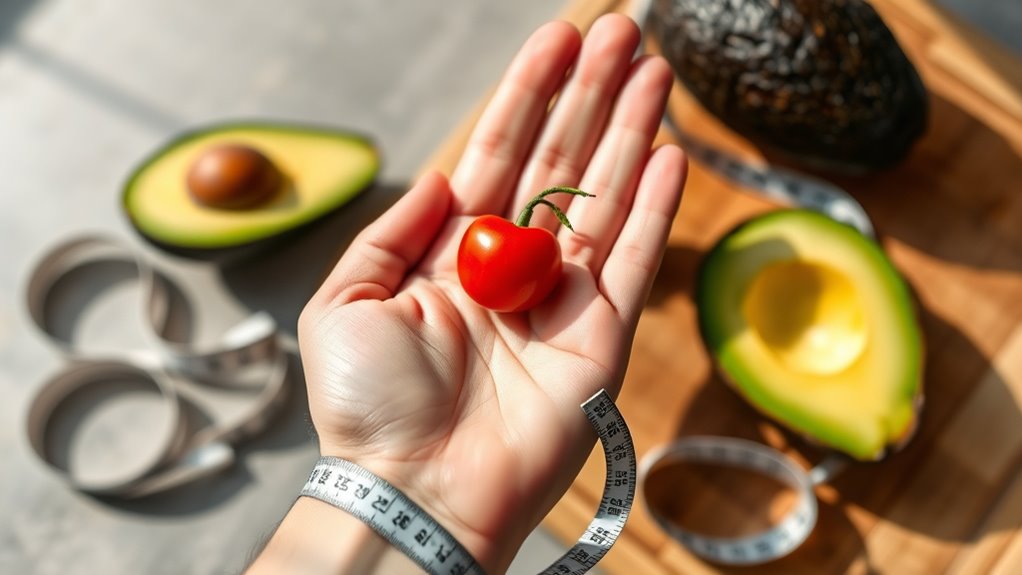
Combining hand measurements allows you to create balanced meals effortlessly. By using your palm, thumb, and fist, you can estimate appropriate portions for different food groups in one meal. For example, include a palm-sized portion of lean protein, a fist of vegetables, and a cupped hand of carbs like grains or starchy vegetables. This method helps guarantee you’re not overeating or under-eating specific nutrients. It also simplifies planning when grocery shopping or preparing meals, as you can visually balance your plate without measuring tools. Keep in mind that adjusting portion sizes based on activity level, age, or dietary needs is important. Combining these measurements makes it easier to enjoy variety and maintain portion control, promoting healthier eating habits overall.
Tips for Accurate Hand-Measurement and Practical Applications

To guarantee your hand measurements are consistent and reliable, it’s helpful to familiarize yourself with some practical tips. First, always measure in the same position—keep your hand relaxed and unflexed. Second, use a mirror or consistent reference point to ensure your hand shape stays the same each time. Third, measure at the same time of day; hands can slightly vary with temperature or activity. Fourth, practice regularly to develop a natural feel for your hand-based portions. Visualize these steps:
- Rest your hand flat on a surface for every measurement.
- Keep your fingers relaxed and slightly spread.
- Use your palm, thumb, or fingertips for different portion sizes.
- Re-measure periodically to maintain accuracy. These habits help make hand measurements a dependable guide for portion control.
Frequently Asked Questions
Can Hand Measurements Be Accurate for All Age Groups?
You might wonder if hand measurements work for everyone, but they aren’t always accurate for all age groups. Children, teens, adults, and seniors have different body sizes and proportions. While hand measurements can be a helpful guide, they’re best used as a rough estimate rather than precise. For accurate portions, especially for children or those with specific dietary needs, it’s better to use standardized measurements or consult a nutritionist.
How Do Hand Sizes Vary Across Different Populations?
While your hand might seem a simple tool, it reminds you that everyone’s size is unique. Across different populations, hand sizes naturally vary due to genetics, age, and lifestyle. You might notice that, in some groups, hands are generally larger or smaller. Recognizing these differences helps you appreciate that no single measurement fits all, encouraging flexibility and awareness when using your hand as a guide for portion sizes.
Are Hand Measurements Suitable for Tracking Specific Dietary Needs?
Hand measurements can be useful for tracking your dietary needs because they offer a quick, portable way to estimate portion sizes. While they work well for general guidance, they might not be precise enough for specific nutritional goals or medical conditions. You should consider using them alongside other methods, like food scales or measuring cups, to guarantee you meet your individual dietary requirements accurately.
Can Hand Measurements Replace Standard Measuring Tools?
While hand measurements are convenient and quick, they shouldn’t fully replace standard measuring tools for precise tracking. You can use your hand as a rough guide for portion sizes, especially when you’re on the go or without access to scale or measuring cups. However, for accuracy—like in baking or managing specific dietary needs—stick to standard tools. Combining both methods helps you stay flexible and precise.
How Should I Adjust Hand Measurements During Physical Activity or Hydration Changes?
Think of your hand as a trusty compass guiding your portion sizes. During activity or hydration changes, your body’s map shifts, so adjust your compass accordingly. If you’re sweating more, your needs might grow, so use your hand to estimate larger portions. Conversely, if you’re less active, scale down. Keep tuning your hand measurements to match your body’s signals, ensuring you’re fueling right no matter the journey.
Conclusion
By using your hand as a guide, you can beautifully paint a balanced picture of your meals without the clutter of scales or measuring cups. Think of your hand as a trusted artist’s palette—each part offering just the right shade to create harmony on your plate. With a little practice, you’ll effortlessly craft nourishing, well-proportioned dishes, turning everyday portions into a vibrant masterpiece of health and flavor.
